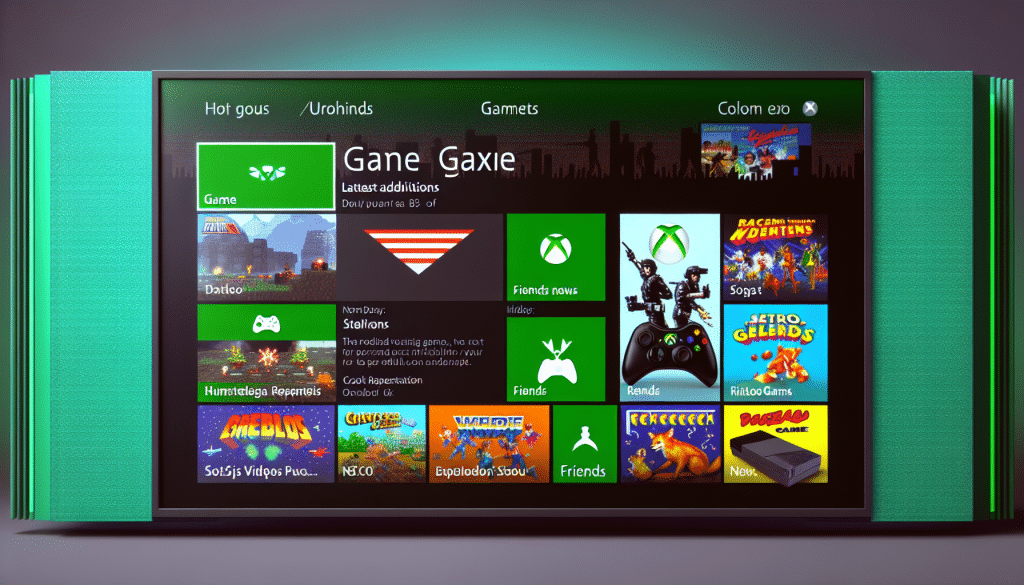Do you have a deep love for retro games? Are you looking to connect with fellow enthusiasts and show off your gaming skills? Well, you’re in luck! Joining an online gaming league dedicated to retro games can be an exciting and fulfilling experience. But before you jump in, it’s important to choose the right retro games for your league. Let’s explore how to make the perfect selection.
1. Choosing the Right Retro Games for an Online Gaming League
When it comes to choosing the retro games for your online gaming league, there are a few key factors to consider. First and foremost, you want to select games that have a passionate and dedicated community. This ensures that you’ll have plenty of fellow players to compete against and that the game will have a thriving competitive scene.
Additionally, it’s important to choose games that offer a fair and balanced playing field. Look for titles that have stood the test of time and are still enjoyable and challenging today. Remember, the goal is to create an engaging and competitive environment for all participants.
Another aspect to consider is the accessibility of the game. While retro games can be nostalgic and beloved, they may not always be easy for new players to pick up and play. It’s important to strike a balance between games that have a dedicated fanbase and ones that are accessible to newcomers. This way, you can attract a diverse range of players and ensure that everyone has a chance to compete.
To narrow down your options, start by doing some research. Explore popular gaming forums and communities to get a sense of which retro games are currently trending. You can also reach out to fellow retro gaming enthusiasts and seek their recommendations. Their insights and experiences can be invaluable in finding the perfect games for your league.
Once you have a shortlist of potential games, it’s time to test them out. Gather a group of dedicated players and organize friendly matches to see how the games hold up in a competitive setting. Pay attention to the balance, mechanics, and overall enjoyment of each game. This hands-on approach will help you make an informed decision and ensure that the selected games will provide an exhilarating experience for all participants.
Remember, the key to a successful retro gaming league lies in the games you choose. By selecting titles with a passionate community, a fair playing field, and accessibility for all players, you’ll be on your way to creating an engaging and competitive environment that will keep everyone coming back for more.
Setting Up an Online Platform for Retro Gaming League Participants
So, you’ve decided to set up an online platform for your retro gaming league participants. That’s fantastic! Creating a dedicated space for like-minded individuals to come together and enjoy their favorite classic games is a wonderful way to build a thriving community. But where do you start? Don’t worry, I’ve got you covered with some expert advice.1. Choose the Right Platform
The first step in setting up your online platform is to choose the right platform itself. There are plenty of options out there, so it’s important to consider your specific needs. Are you looking for a simple forum-style platform or a more interactive experience? Do you want built-in features like leaderboards and chat rooms? Take the time to research and explore different platforms before settling on the one that best suits your retro gaming league.2. Create User-Friendly Registration and Login Processes
Once you’ve chosen your platform, it’s time to focus on creating user-friendly registration and login processes. Make sure that signing up for your retro gaming league is a seamless and straightforward experience. Avoid requiring too much personal information and keep the registration form short and sweet. Additionally, consider implementing social media login options to make it even easier for participants to join.3. Design an Engaging and Intuitive Layout
The layout of your online platform plays a crucial role in keeping participants engaged. Opt for a clean and intuitive design that allows users to navigate effortlessly. Organize different sections for game discussions, league updates, and community events. Consider using visual cues, such as icons and graphics, to make the platform visually appealing and user-friendly.4. Ensure Reliable and Secure Server Infrastructure
To provide an optimal gaming experience, it’s essential to invest in reliable and secure server infrastructure. Slow loading times and frequent downtime can be frustrating for participants, so choose a hosting provider that offers excellent performance and uptime guarantees. Additionally, prioritize security measures, such as SSL certificates and regular backups, to protect your participants’ personal information.5. Implement Communication Channels
Communication is key when it comes to fostering a vibrant retro gaming community. Provide participants with various communication channels, such as forums, chat rooms, and even voice chat options. Encourage active participation and friendly discussions among members. Moderation is also vital to ensure a positive and respectful environment for everyone involved.6. Develop an Events Calendar
Organizing regular events and tournaments is an effective way to keep participants engaged and excited about your retro gaming league. Develop an events calendar and highlight upcoming competitions, game nights, and community challenges. This will encourage participants to interact and plan their gaming sessions accordingly, fostering a sense of camaraderie and healthy competition.7. Provide Useful Resources and Guides
To support participants in their retro gaming endeavors, provide them with useful resources and guides. Create a section on your platform dedicated to game walkthroughs, tips, and tricks. Encourage experienced players to share their knowledge and help newcomers navigate the world of retro gaming. By fostering a supportive community, you’ll create an atmosphere of continuous learning and improvement.8. Seek Feedback and Continuous Improvement
Finally, always seek feedback from your retro gaming league participants and be open to continuous improvement. Regularly ask for suggestions and listen to their needs. Implement new features and updates based on their input to enhance the overall experience. Remember, your platform exists for them, so their opinions and ideas should be valued and incorporated whenever possible. Setting up an online platform for your retro gaming league can be an exciting and rewarding endeavor. By choosing the right platform, creating a user-friendly experience, and fostering a vibrant community, you’ll be well on your way to providing a space where retro gaming enthusiasts can come together and relive the glory days of their favorite classics.Establishing Competitive Rules and Ranking Systems for Retro Gaming Leagues
So you’ve chosen the perfect retro games for your online gaming league and set up a platform for participants to connect and compete. But how do you ensure fairness and maintain a sense of healthy competition? That’s where establishing competitive rules and ranking systems comes in.
1. Define Clear and Consistent Rules
First and foremost, it’s crucial to establish clear and consistent rules for your retro gaming league. These rules should cover various aspects, such as gameplay mechanics, conduct, and game settings. Make sure to communicate these rules to all participants and enforce them consistently to maintain a level playing field.
Consider creating a rulebook that participants can easily refer to for guidance. This rulebook should outline the specific rules and regulations for each game included in the league, including any restrictions or special conditions.
2. Implement a Ranking System
A ranking system adds an extra layer of excitement and motivation to your retro gaming league. It allows participants to track their progress and compare their skills with others. There are several ways to implement a ranking system, depending on the nature of your league and the games involved.
One option is to use a point-based system, where participants earn points based on their performance in each game. These points can then be tallied to determine their overall ranking. Another option is to use a tier-based system, where participants are grouped into different skill levels or divisions based on their performance. They can then compete within their respective tiers to move up the ranks.
Consider using a leaderboard to display the rankings in a transparent and accessible manner. This not only adds a competitive element but also enhances the sense of community within your retro gaming league.
3. Regularly Update and Evolve the Rules and Ranking System
The gaming landscape is constantly evolving, and it’s important to adapt your rules and ranking system accordingly. Stay up to date with new game releases, patches, and balance changes that may impact the competitiveness of your league.
Engage with your community and gather feedback on the rules and ranking system. This feedback can help you identify areas of improvement and make necessary adjustments. Encourage open communication and listen to the concerns and suggestions of your participants to ensure a fair and enjoyable gaming experience for everyone involved.
4. Promote Sportsmanship and Fair Play
While competition is at the heart of any gaming league, it’s essential to promote sportsmanship and fair play among participants. Emphasize the importance of respectful behavior, both in-game and in any community spaces associated with your retro gaming league.
Encourage participants to engage in friendly banter and constructive feedback, but discourage any form of harassment, cheating, or unsportsmanlike conduct. Make it clear that violations of these rules can result in penalties or even expulsion from the league.
5. Reward and Recognize Achievements
To further motivate participants and foster a sense of accomplishment, consider implementing a rewards system. This can involve providing badges, trophies, or special recognition for exceptional performances or milestones reached within the retro gaming league.
Publicly acknowledge and celebrate the achievements of participants through social media, newsletters, or dedicated sections on your online platform. This not only encourages healthy competition but also builds a positive and supportive community.
Remember, the goal of establishing competitive rules and ranking systems for your retro gaming league is to create an environment that fosters skill development, camaraderie, and fun. By setting clear guidelines, implementing fair ranking systems, and promoting sportsmanship, you can ensure a thriving and enjoyable experience for all retro gaming enthusiasts involved.
Fostering a Thriving Community for Retro Gaming Enthusiasts
Welcome to the wonderful world of retro gaming! Whether you’re an old-school gamer looking to relive the nostalgia of your childhood or a new generation gamer curious about the games that started it all, joining a retro gaming league can be an incredibly rewarding experience. Not only do you get to connect with like-minded individuals who share your passion, but you also have the opportunity to showcase your skills and compete against the best of the best. So, how can you foster a thriving community for retro gaming enthusiasts? Let’s dive in!
1. Create a Welcoming Environment
The first step in building a vibrant retro gaming community is to create a welcoming environment where everyone feels comfortable and included. Encourage participants to introduce themselves and share their gaming experiences. Foster a culture of respect and support, where gamers can freely discuss their favorite games, strategies, and even challenges they face. By creating a positive and inclusive space, you’ll lay the foundation for a thriving community.
2. Organize Events and Tournaments
Hosting regular events and tournaments is a fantastic way to bring the retro gaming community together and keep the excitement alive. Consider organizing online gaming sessions where participants can compete against each other in different retro games. You can even introduce themed tournaments or challenges to add an extra element of fun. Don’t forget to include a leaderboard or ranking system to keep track of participants’ progress and celebrate their achievements.
3. Encourage Collaboration and Sharing
Retro gaming is all about nostalgia and shared experiences. Encourage community members to collaborate and share their knowledge. This can be done through online forums, social media groups, or even dedicated chat channels. By sharing tips, tricks, and strategies, gamers can learn from each other and enhance their skills. Additionally, consider organizing game nights where participants can play together and discuss their favorite moments. This sense of community and camaraderie will make the retro gaming experience even more enjoyable.
4. Highlight Achievements and Milestones
Everyone loves recognition and appreciation for their hard work and dedication. Make sure to highlight achievements and milestones within the retro gaming community. Whether it’s reaching a new high score, completing a challenging level, or mastering a difficult game, celebrating these accomplishments will motivate and inspire others. Share success stories on your online platform, create a “Hall of Fame,” or even award virtual badges or trophies to honor gamers’ achievements.
5. Embrace Diversity and Variety
Retro gaming is a vast and diverse realm, encompassing a wide range of games and consoles. Embrace this diversity within your community. Encourage participants to explore different genres, platforms, and eras of retro gaming. Host events that showcase lesser-known games or hold friendly competitions centered around specific themes. By embracing diversity, you’ll create a community that caters to the interests and preferences of all retro gaming enthusiasts.
6. Connect with Other Retro Gaming Communities
Building a thriving retro gaming community doesn’t mean you have to do it alone. Connect with other retro gaming communities and collaborate on events or initiatives. This can be done through partnerships, guest appearances, or even joint tournaments. By expanding your network, you’ll not only bring more visibility to your community but also provide opportunities for your members to connect with a wider range of gamers.
By following these steps, you can foster a thriving community for retro gaming enthusiasts. Remember, the key is to create a welcoming and inclusive environment, organize events and tournaments, encourage collaboration and sharing, highlight achievements, embrace diversity, and connect with other communities. So, put on your favorite retro gaming t-shirt, grab your joystick or controller, and get ready to embark on an exciting journey filled with pixelated adventures!













1 thought on “Organizing Online Retro Gaming Leagues”
Thanks for sharing. I read many of your blog posts, cool, your blog is very good.